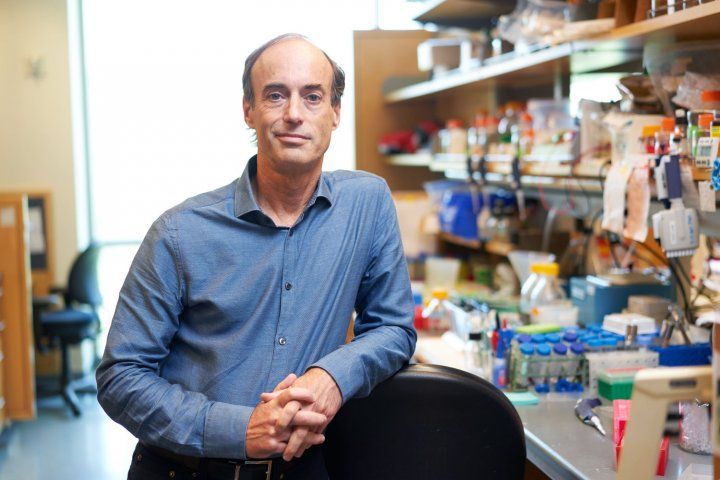Ron Vale Receives 2019 Gairdner Award for Pioneering Work on Molecular Motors
Ronald D. Vale, PhD, professor of cellular and molecular pharmacology at UC San Francisco, was named a winner of the 2019 Canada Gairdner International Award, one of the most prestigious awards in the biomedical sciences. The award is presented annually to five researchers – each of whom receives a $100,000 (CAD) prize – who have made fundamental discoveries that improve our understanding of human health.
Vale, also a Howard Hughes Medical Institute (HHMI) investigator, was recognized for his “landmark discovery” of the motor protein kinesin (pronounced “kin-EE-zin”), which transports molecular cargo along the cell’s internal highways and plays a crucial part in cell division. As a Gairdner recipient, Vale joins an elite group of scientists that includes 89 Nobel laureates.

In a pioneering study published in 1985, Ron Vale, PhD, established kinesin as the motor that transported molecular cargo along the length of nerve fibers. Photo by Steve Babuljak
“Dr. Vale’s transformative research has been critical to understanding the fundamental principles of biological motility. We are thrilled to be recognizing his important work on the 60th anniversary of the Canada Gairdner Awards,” said Janet Rossant, PhD, president and scientific director of the Gairdner Foundation.
Widely recognized for his scientific contributions, Vale is also a staunch advocate for science education. In acknowledging the award, he commended the Gairdner Foundation, which sponsors the prize, for its own efforts to advance science education.
“It is very exciting to have been selected to receive the Gairdner Award,” Vale said. “In addition to their recognition of important science, I very much appreciate the work that the Gairdner Foundation does in science outreach to high school students and I look forward to participating in their program.”
El Niño-Related Squid Shortage Sets Stage for Breakthrough
Vale’s breakthrough discovery may never have happened had it not been for events spurred by the 1982–83 El Niño – “the worst there ever was” according to one oceanographer – which caused a precipitous decline in the squid population along the Northern California coast. Vale needed squid for his experiments, but in the waters nearest Stanford there were none to be found.
Squid are hardly the first creatures that spring to mind when one imagines breakthroughs in molecular biology. But these cephalopods have played an outsize role in 20th century biology thanks to a remarkable anatomical feature: the “giant axon.” This unusually thick nerve fiber found in squid — some 50 times wider than the average human axon – allows them to make quick, sudden movements to elude potential predators, and also makes the axon more amenable to study than most mammalian nerve fibers.
In the 1950s, Alan Hodgkin and Andrew Huxley discovered action potentials – the electrical impulses responsible for communication in the brain and nervous system – by conducting experiments using the squid’s giant axon. In the mid-’80s, Vale turned to the same anatomical system to figure out how molecular cargo is transported from the tips of lengthy nerve fibers to the faraway neurons from which they project.
But thanks to El Niño, Vale headed east for a research stint at the Marine Biological Laboratory in Woods Hole, Massachusetts. Not only were squid plentiful along the Cape Cod coast, the new setting also provided Vale an opportunity to learn from and work with a team of scientists who had recently made major technical advances in microscopy. With fresh squid and new techniques in hand, Vale and his colleagues Bruce Schnapp, PhD, Tom Reese, MD, and Michael Sheetz, PhD, were well-equipped to make seminal discoveries.
In a pioneering study published in 1985, Vale established kinesin as the motor that transported molecular cargo along the length of nerve fibers. He also showed that this movement occurred along cellular highways known as microtubules. Since then, Vale and other researchers have built on these initial findings and resolved how this critical motor protein converts chemical energy into motion.
The kinesin protein that Vale initially discovered turned out to be but one member of a much larger kinesin superfamily. There are 45 different kinesins in humans alone, and these motor proteins can be found in virtually all eukaryotes – the group that includes animals, plants and fungi. In addition to intracellular transport, kinesin is essential for cell division and development. Kinesin also plays a role in a number of neurodegenerative diseases, developmental disorders and cancers. Since discovering kinesin and elucidating how it works, Vale has expanded the scope of his work to include dyneins, another family of essential motor proteins.
Vale Adds New Chapter to UCSF’s History of Prizewinning Discoveries
In addition to the Gairdner, Vale has received a number of esteemed scientific awards, including the 2012 Albert Lasker Basic Medical Research Award and the 2017 Shaw Prize in Life Sciences and Medicine. He has also been named a lifetime fellow of many of the most prestigious scientific societies, including the National Academy of Sciences and National Academy of Medicine.
“Ron’s pioneering efforts have helped elucidate the exquisite molecular machinery that drives the cell’s internal roadways. His work has opened new avenues of research and continues to illuminate the majestic beauty and astounding complexity of the cell,” said UCSF Chancellor Sam Hawgood, MBBS. “The Gairdner Award is a tremendous honor, and on behalf of the entire UCSF community, I’m proud to congratulate Ron for this well-deserved recognition.”
Past UCSF recipients of the Gairdner Award include Nobel Laureates J. Michael Bishop, MD; Elizabeth Blackburn, PhD; Stanley Prusiner, MD; Harold Varmus, MD; and the Gladstone Institutes’ Shinya Yamanaka, MD, PhD; as well as Bruce Alberts, PhD; John Clements, MD; Y.W. Kan, MD, FRS; Peter Walter, PhD; and David Julius, PhD.
An HHMI investigator since 1995, Vale was recently named the next executive director of HHMI’s Janelia Research Campus and HHMI vice president, starting in 2020. He will remain a member of the UCSF faculty while serving at HHMI.